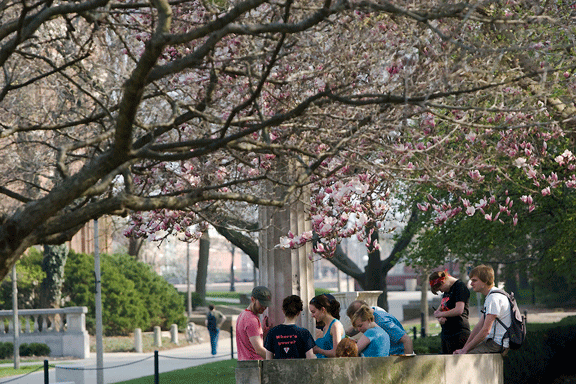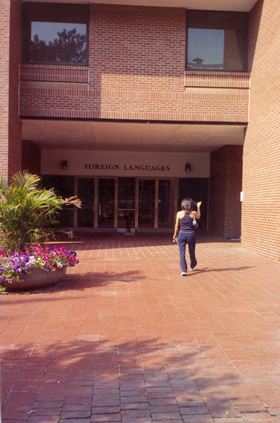Introduction to Chapter 4
This chapter attempts to take into our field of vision those who cross national borders, with our focus turned toward local and global influences on the languages we speak and write. We also attempt to heed Nedra Reynolds' (2004) contention that "places are hugely important to learning processes and to acts of writing because the kinds of spaces we occupy determine, to some extent, the kinds of work we can do or the types of artifacts we can create" (p. 157). And we attend as well to Christopher Keller's (2004) admonition of the importance of connecting classrooms to other crucial locations in research participants' lives. As he notes, "Ethnographic practices…need to consider how the classroom is a location that connects to other locations, locations that subjects constantly inhabit, dwell in, and move between" (p. 210).

Students at the University of Illinois at Urbana-Champaign, where Vanessa, Ismael,
and Hannah were graduate students
Through coauthorship and through attempts to put the tools of research in the hands of participants, in this chapter we continue to explore the language and digital literacy practices of people in the global and local contexts that they inhabit. In other words, we seek, through a variety of what we deem socially responsible approaches, to understand the participants' digital literacy practices and uses of language in and out of school and in various spaces that mark their literate activity (Prior, 1998).
Regardless of the particular homeland from which each hails, knowledge of English—proficiency in both the spoken and the written language—has been of critical importance to the study's many coauthors, whether in academic settings, their home communities, or on visits to other countries.
Although literate activity in multiple languages from across the globe should be increasingly valued, the inability to work easily in English is often viewed as a sign of being less educated, even in countries where English is not the home language (Mesthrie & Bhatt, 2008).

Vanessa in front of the Foreign Language Building at the University of Illinois.
In this chapter coauthors Vanessa Rouillon, Ismael Gonzalez, and Hannah Kyung Lee describe in print and through video representations some of the different kinds of language challenges they confront in their daily lives as they cross national boundaries, on their way to teaching abroad or to earning advanced degrees.
Literacy Narratives, Writing Process Videos, and Language Matters
When we met in 2005 and 2006, the graduate-student coauthors of this chapter were, like many, busy with their studies and academic jobs yet nevertheless connected to locations and contexts that were far from their current homes. Vanessa, Ismael, and Hannah were all master's degree students attending the University of Illinois, Urbana-Champaign, but each of the three had taken a very different path to pursuing graduate studies.
Vanessa had already, in 1994, earned a master's degree in economics from Georgetown University in Santiago, Chile, and was in the process of earning another master's degree in EIL (English as an international language); Ismael, who claims Puebla, Mexico, as his home city, was also working on a master's degree in EIL; and Hannah, born in Chicago, USA, of Korean parents, had just returned from teaching in Paris, France, and was starting classes that would culminate in master's degrees in writing studies and library and information science.
Unsurprisingly, despite all occupying transnational landscapes, the participants differed markedly in terms of their motivations, experiences, education, attitudes toward language, and positioning within the topographies fashioned by globalization. Our efforts to understand their stories—how literacy, language, schooling, travel, family ties, and technology are inexplicably connected to transnational lives—led us to continue exploring in greater depth the use of digital video as a research and learning tool and to ask the coauthors to engage in a variety of literate practices, such as composing digital video narratives, compiling alphabetic and digital portfolios, and composing ongoing e-mail messages connected to stories of literacy.
previous < > CHAPTER 4: Vanessa Rouillon




